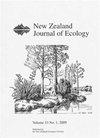Dual aerial 1080 baiting operation removes predators at a large spatial scale
IF 1.4
3区 环境科学与生态学
Q3 ECOLOGY
引用次数: 9
Abstract
As New Zealand attempts to become predator free by 2050, transitioning aerial 1080 (sodium fluoroacetate) operations from predator control to complete predator removal has become an important research objective. Aerial 1080 operations may not remove every last target animal, but they may be able to remove a very high proportion (> 0.99). We trialled a modified [dual] aerial 1080 operation for the removal of brushtail possums (Trichosurus vulpecula), ship rats (Rattus rattus), and stoats (Mustela erminea) at large spatial scale. Our trial involved two toxin applications (TA#1 & TA#2), each preceded by two applications of non-toxic pre-feed bait. Different types of cereal baits and lures were used for each toxin application. Camera traps (n = 142; 200–1431 m asl) were used to detect the target species and to incidentally observe house mouse (Mus musculus), birds, and ungulates across the study area. The operation had no significant impact on the number of cameras detecting most birds and ungulate species; however, house mouse, blackbird (Turdus merula), and red deer (Cervus elaphus) were detected on significantly fewer cameras after TA#1 than before. Numbers of cameras that detected target species were significantly reduced for all three target species after TA#1, and significantly reduced again for possums after TA#2, when no stoats were detected on cameras and a small number of cameras detected rats. Mean relative abundance estimates based on camera trap indices (proportion of camera trap days that target species were detected) showed the operation appears to have removed over 99% of ship rats, stoats, and possums.双空中1080诱饵操作在大的空间尺度上消除捕食者
由于新西兰试图在2050年前实现无捕食者的目标,将空中1080(氟乙酸钠)操作从控制捕食者过渡到完全消灭捕食者已成为一个重要的研究目标。空中1080操作可能不会移除最后一个目标动物,但它们可能能够移除非常高的比例(>.99)。我们试验了一种改进的[双]空中1080手术,在大空间尺度上去除帚尾负鼠(Trichosurus vulpecula)、鼠(Rattus Rattus)和白鼬(Mustela erminea)。我们的试验涉及两次毒素应用(ta# 1和ta# 2),每次应用之前都使用两次无毒饵料。每次施用毒素时使用不同类型的谷物诱饵和诱饵。相机陷阱(n = 142;在200-1431米(海拔高度)范围内对目标物种进行检测,并对研究区域内的家鼠(小家鼠)、鸟类和有蹄类动物进行偶然观察。该行动对大多数鸟类和有蹄类的相机数量没有显著影响;然而,家鼠、黑鹂(Turdus merula)和马鹿(Cervus elaphus)在第一次测试后的摄像机上被检测到的数量明显少于之前。在ta# 1之后,检测到目标物种的摄像机数量显著减少,在ta# 2之后,当摄像机上没有检测到白鼬,而少量摄像机检测到老鼠时,检测到目标物种的摄像机数量再次显著减少。根据摄像机陷阱指数(检测到目标物种的摄像机陷阱天数比例)估计的平均相对丰度显示,该行动似乎已清除了99%以上的船鼠、白鼬和负鼠。
本文章由计算机程序翻译,如有差异,请以英文原文为准。
求助全文
约1分钟内获得全文
求助全文
来源期刊

New Zealand Journal of Ecology
环境科学-生态学
CiteScore
3.00
自引率
12.50%
发文量
35
审稿时长
>36 weeks
期刊介绍:
The New Zealand Journal of Ecology is a biannual peer-reviewed journal publishing ecological research relevant to New Zealand/Aotearoa and the South Pacific. It has been published since 1952 (as a 1952 issue of New Zealand Science Review and as the Proceedings of the New Zealand Ecological Society until 1977). The Journal is published by the New Zealand Ecological Society (Inc.), and is covered by Current Contents/Agriculture, Biology and Environmental Science, GEOBASE, and Geo Abstracts.
 求助内容:
求助内容: 应助结果提醒方式:
应助结果提醒方式:


